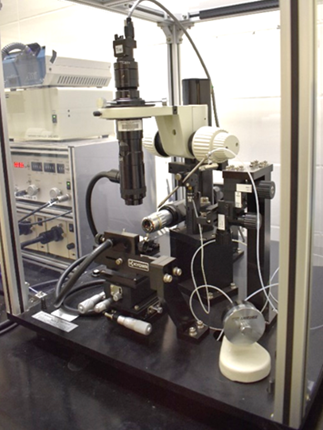Microscopic Contact Angle Meter
Description:
The contact angle is the angle at which a liquid/vapor interface meets the solid surface. The contact angle is a result of the interface/surface tensions (surface free energy) between liquid and solid surrounded by vapor. Contact angle measurement is a quick and easy way to evaluate the cleanness of a solid surface. The main application of contact angle study is to assess the wettability of solid surfaces, or the solid/liquid interaction. Other physical properties such as affinity, adhesion, and repellency may also be derived from the contact angle measurements. The Contact Angle Meter at CharFac employs the sessile drop method to measure the contact angle. The most unique capability of this instrument is to conduct contact angle measurements microscopically. The liquid is dispensed out of a capillary with diameter varying from 5 to 50 µm, and a droplet with volume of 1×10-3 to 10-5 µL can be accurately produced and deposited on the surfaces. A high speed camera continuously captures images from the moment the droplet adheres to the surface. An automated algorithm can be applied to each image to measure the contact angles.
Equipment and Capabilities:
The MCA-3, an image analysis contact angle meter from Kyowa Interface Science Co (Japan), can accurately produce droplets as microscopic as 1×10-3 to 10-5 µL on extra fine patterns under 100 µm wide, which were impossible to measure by conventional contact angle meters. The unique features of this instrument include:
- High magnification lens and x12 zoom allows a field of view from about 75 x 56 µm to 900 x 670 µm.
- Available in three capillaries with inner diameters of 5 µm, 30 µm and 50 µm.
- Special pneumatic dispensing system allows dispensing excellent volume of droplets.
- Equipped with a pixel calibration tool to show the actual size of droplets.
- Equipped with one vertical camera and one horizontal camera. Both cameras can take 125 frames per second. The vertical camera provides a top view of the droplet. It enables pinpoint measurements of a micro-area, and allows observation of the wetting broadening behavior of the droplet. The photos from the horizontal camera are used to calculate the contact angles and show droplet changes/contact angle changes.
- Image data can be replayed as a movie.
